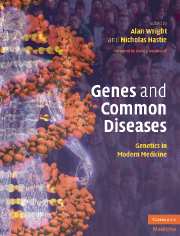Book contents
- Frontmatter
- Contents
- List of Contributors
- Foreword
- Section 1 Introductory Principles
- 1 Genes and their expression
- 2 Epigenetic modification of chromatin
- 3 Population genetics and disease
- 4 Mapping common disease genes
- 5 Population diversity, genomes and disease
- 6 Study design in mapping complex disease traits
- 7 Diseases of protein misfolding
- 8 Aging and disease
- 9 The MHC paradigm: genetic variation and complex disease
- 10 Lessons from single gene disorders
- 11 Environment and disease
- 12 Contemporary ethico-legal issues in genetics
- Section 2 Common Medical Disorders
- Index
- References
10 - Lessons from single gene disorders
Published online by Cambridge University Press: 17 August 2009
- Frontmatter
- Contents
- List of Contributors
- Foreword
- Section 1 Introductory Principles
- 1 Genes and their expression
- 2 Epigenetic modification of chromatin
- 3 Population genetics and disease
- 4 Mapping common disease genes
- 5 Population diversity, genomes and disease
- 6 Study design in mapping complex disease traits
- 7 Diseases of protein misfolding
- 8 Aging and disease
- 9 The MHC paradigm: genetic variation and complex disease
- 10 Lessons from single gene disorders
- 11 Environment and disease
- 12 Contemporary ethico-legal issues in genetics
- Section 2 Common Medical Disorders
- Index
- References
Summary
Introduction
It has been estimated that there are on the order of 6000 single gene disorders, most inherited as X-linked recessive, autosomal dominant or autosomal recessive Mendelian conditions (McKusick, 1998). In total, approximately 1% of the population is born with or will develop a disease through carrying such single gene mutations.
Even before the completion of the Human Genome sequence (International Human Genome Sequencing Consortium, 2001; Venter et al., 2001), heroic positional cloning efforts had successfully identified the genes mutated in 1000 or so of these disorders. Since the genome sequence has been available, the remainder are being picked off at an astonishing rate, the limiting factor now being the small number of affected individuals in some of the most rare conditions.
Identification of the genes mutated in Mendelian disorders has led to profound insights into disease mechanisms and, in some instances, has already had a clinical impact. Perhaps the most dramatic examples are phenylketonuria and bowel cancer, where identification of the underlying genetic cause has led to cures through nutritional and surgical intervention, respectively. In a number of cases, identification of the genes has enabled prenatal diagnosis with the offer of termination of pregnancy. Finally, in a few conditions the genetic breakthroughs have led to novel therapies, either pharmacological or immunological. Another enormous bonus is the profound impact that knowledge of these genes and their products has had on our understanding of basic biological processes.
- Type
- Chapter
- Information
- Genes and Common DiseasesGenetics in Modern Medicine, pp. 152 - 163Publisher: Cambridge University PressPrint publication year: 2007



